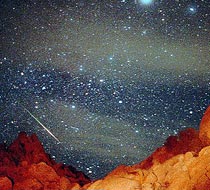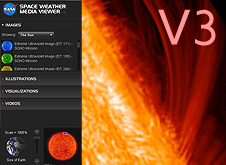National Aeronautics and Space Administration
Goddard Space Flight Center

Sun-Earth Day 2010: Magnetic Storms
What's Up?

Photo from the 2009 Leonids meteor shower.
What's Up? Leonids!
By Lou Mayo
This year, on the night of November 17th, observers in Asia and North America could be treated to an unusually strong meteor shower. The Leonids meteor shower is produced every November when the Earth passes through the debris left by comet 55P Temple-Tuttle. Most meteor showers are caused by swarms of dust particles - most the size of a grain of sand, that are liberated off the surfaces of comets. How does this happen? Comets travel in highly eccentric orbits around the sun. When they are far from the sun, volatiles such as water, CO, CO2, methane, and ethane are frozen solid, probably lying just below the comet nucleus' dry, rocky surface. But when they come into the inner solar system, these frozen gasses begin to sublime back into their gas phase, shooting out of the surface and releasing other materials like silicates. The liberated dust grains continue to orbit the sun in approximately the same path as the comet nucleus. Each year, the Earth passes through this debris for certain comets and we have a meteor shower. Sometimes the Earth passes through a relatively thin or rarified part of the stream and we see only a few meteors. This year, it is predicted that the Earth will pass through a relatively dense part of 55P Temple-Tuttle's debris field and observers in dark locations could see ZHRs (Zenith Hourly Rates) of 500 meteors per hour or more, peaking sometime around 22:00 UT though peak activity could occur as much as an hour later than this.
How to observe
To view a meteor shower, you won't need a telescope or binoculars. Although I sometimes bring binoculars just to have something else to do since watching meteors can take several hours. First, try to find a relatively dark site. The darker the site, the more meteors you will see, Dress warmly. You might bring a sleeping bag or even a reclining lounge chair and something to drink. Bring a watch to tell time. Then just lie down and watch the sky. You may also see satellites and if you stay out long enough, you will notice the sky shifting as new constellations rise and others set. You can try counting meteors to get your own ZHR. Paper and pencil are good for this. Just make a mark each time you see one over the course of an hour.
NASA Fact
The August 4, 1972 solar flare was so powerful that, by some estimates, a spacesuited astronaut would have received a lethal does of radiation.


